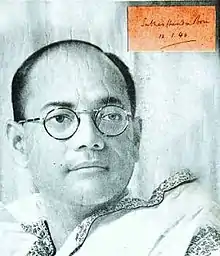Anita Bose Pfaff
Anita Bose Pfaff (born 29 November 1942) is a German economist, who has previously been a professor at the University of Augsburg as well as a politician in the Social Democratic Party of Germany.[2] She is the daughter of Indian freedom fighter Subhas Chandra Bose (1897–1945) and his wife, [3][lower-alpha 1] or companion,[4][lower-alpha 2] Emilie Schenkl.[3][lower-alpha 3]
Anita Bose Pfaff | |
|---|---|
 Anita Bose Pfaff and the former President of India, Pranab Mukherjee. | |
| Born | Anita Schenkl 29 November 1942 |
| Spouse(s) | Martin Pfaff |
| Children |
|
| Parent(s) | |
Early life
Pfaff is the only child of Emilie Schenkl and Subhas Chandra Bose, who—with a view to attempting an armed attack on the British Raj with the help of Imperial Japan—left Schenkl and Pfaff in Europe, and moved to southeast Asia, when Pfaff was four months old.[5][lower-alpha 4] Pfaff was raised by her mother, who worked shifts in the trunk office during the postwar years to support the family, which included Pfaff's maternal grandmother.[6] Pfaff was not given her father's last name at birth, and grew up as Anita Schenkl. Her father was not there with her as he was busy with his army Azad Hind Fauj and was brought up by her mother Emilie Schenkl.[6]
Academic career
As of 2012, Pfaff was a Professor of Economics at the University of Augsburg.[2]
Marriage and family
Pfaff is married to Professor Martin Pfaff, who was previously a member of the Bundestag (the German parliament), representing the SPD. They have three children: Peter Arun, Thomas Krishna and Maya Carina.[7]
Media
Pfaff is mentioned in the Bollywood film Netaji Subhas Chandra Bose: The Forgotten Hero.[8]
Notes
- "How the Bose family discovered Netaji had a child".
- "'To have an iconic dad is, of course, difficult' says Anita Bose Pfaff, Netaji Subhash Chandra Bose's daughter".
- Hayes 2011, p. 15.
- Gordon 1990, pp. 344–345.
- Hayes 2011, p. 159.
- Madhuri Bose (12 November 2015). The Bose Brothers and Indian Independence: An Insider’s Account. SAGE Publications. ISBN 978-93-5150-396-5.
- "Netaji's daughter speaks!". www.rediff.com.
- "Netaji Subhas Chandra Bose: The Forgotten Hero" – via www.imdb.com.
National Congress
References
Notes
- "While writing The Indian Struggle, Bose also hired a secretary by the name of Emilie Schenkl. They eventually fell in love and married secretly in accordance with Hindu rites."[3]
- "Although we must take Emilie Schenkl at her word (about her secret marriage to Bose in 1937), there are a few nagging doubts about an actual marriage ceremony because there is no document that I have seen and no testimony by any other person. ... Other biographers have written that Bose and Miss Schenkl were married in 1942, while Krishna Bose, implying 1941, leaves the date ambiguous. The strangest and most confusing testimony comes from A. C. N. Nambiar, who was with the couple in Badgastein briefly in 1937, and was with them in Berlin during the war as second-in-command to Bose. In an answer to my question about the marriage, he wrote to me in 1978: 'I cannot state anything definite about the marriage of Bose referred to by you, since I came to know of it only a good while after the end of the last world war ... I can imagine the marriage having been a very informal one ...'... So what are we left with? ... We know they had a close passionate relationship and that they had a child, Anita, born 29 November 1942, in Vienna. ... And we have Emilie Schenkl's testimony that they were married secretly in 1937. Whatever the precise dates, the most important thing is the relationship."[4]
- "Apart from the Free India Centre, Bose also had another reason to feel satisfied-even comfortable-in Berlin. After months of residing in a hotel, the Foreign Office procured a luxurious residence for him along with a butler, cook, gardener and an SS-chauffeured car. Emilie Schenkl moved in openly with him. The Germans, aware of the nature of their relationship, refrained from any involvement. The following year she gave birth to a daughter.[3]
- "By the time Bose left, he had more or less obtained what he wanted: a submarine to go off to Asia, limitations as to how and where the Legion could be used (the only one in fact not directed at the Soviet Union), Luftwaffe training, at a time when Germany suffered a serious dearth in aircraft, acceptance of left-wing Indians in high-ranking positions and even racial exemptions to marry German women? Bose himself was the prime example, living and conceiving a child openly as he did with Emilie Schenkl, in complete defiance of Nazi racial laws."[5]
Citations
- Bose, Sarmila (2005), "Love in the Time of War: Subhas Chandra Bose's Journeys to Nazi Germany (1941) and towards the Soviet Union (1945)", Economic and Political Weekly, 40 (3): 249–256, JSTOR 4416082
- Bose, Sugata (2011), His Majesty's Opponent: Subhas Chandra Bose and India's Struggle against Empire, Harvard University Press, ISBN 978-0-674-04754-9, retrieved 22 September 2013
- Gordon, Leonard A. (1990), Brothers against the Raj: a biography of Indian nationalists Sarat and Subhas Chandra Bose, Columbia University Press, ISBN 978-0-231-07442-1, retrieved 17 November 2013
- Hayes, Romain (2011), Subhas Chandra Bose in Nazi Germany: Politics, Intelligence and Propaganda 1941-1943, Oxford University Press, ISBN 978-0-19-932739-3, retrieved 22 September 2013
